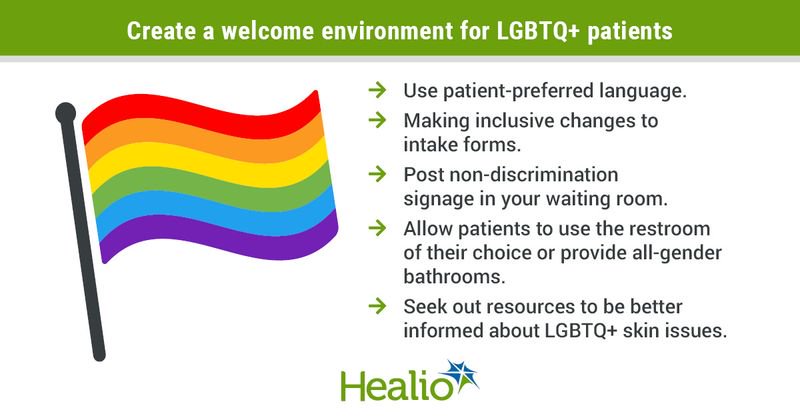Q&A: LGBTQ+ patients require specific, specialized dermatological care
Members of the LGBTQ+ community often have specific, varying dermatological issues that require specialized care.
Healio spoke with Howa Yeung, MD, assistant professor of dermatology at Emory University School of Medicine, regarding those issues and how dermatology practitioners can be best prepared to care for their LGBTQ+ patients.

Q. What are some of the biggest dermatologic concerns in the LGBTQ+ community, and how can dermatologists work with patients to address these needs?
A. The most important concern right now is for dermatologists to recognize that important dermatological concerns exist in LGBTQ+ communities. Most dermatologists have not historically considered their patients’ sexual orientation and gender identity as relevant to their practice. Emerging data have begun to build awareness in skin health disparities in LGBTQ+ communities, showing higher risks for skin cancer and indoor tanning in gay and bisexual men and specific acne and hair-related issues in transgender persons undergoing gender affirmation treatment. However, dermatologists will not get to learn about any of these concerns unless we take proactive steps to show a respect toward our patients and to learn who our patients are. Many patients have had prior negative health care experiences and do not take welcoming health care environments for granted. So, as a first step, dermatologists should create a welcoming environment and should routinely collect information about sexual orientation and gender identity information, so we begin to understand our patients and their specific skin health concerns.

Q. What are some of the specific issues facing transgender individuals that can be addressed with dermatological treatment before, during and after transition?
A. We continue to learn more and more about skin health in transgender patients. Transgender patients undergoing masculinizing hormone therapy with testosterone often have acne, which could be disfiguring and could worsen over time. Isotretinoin is required for severe cases; it is challenging and rewarding to help patients navigate the FDA iPLEDGE system and working with multidisciplinary care teams to ensure safety and to address transition care goals. Transgender patients undergoing feminizing hormone therapy often continue to have facial hirsutism or pseudofolliculitis barbae despite optimized hormone therapy. Transgender patients seeking genital surgery will also require permanent hair removal for surgical flap/graft preparation. Laser hair removal can be life-changing in these cases.
Q. What are some things dermatology practitioners can do to ensure their LGBTQ+ patients feel comfortable with treatment?
A. First, it is important to have a growth mindset. Many dermatologists do not want to say the wrong thing and end up avoiding acknowledging or treating LGBTQ+ patients. Practicing medicine should include practicing on improving care for LGBTQ patients; having feedback from our patients helps us improve our clinical interactions and encounters. Second, it is important to teach yourself and your staff members to create a welcoming environment. These are small but very meaningful steps to demonstrate respect to patients, such as using patient-preferred language, posting nondiscrimination signage in your waiting room, making small inclusive changes to your patient intake forms, and allowing patients to use the restroom of their choice or providing all-gender bathrooms. Third, it is important to show patients that you ask about sexual orientation and gender identity to improve patient care rather than just being nosy. As dermatologists, we know how sexual health intertwines with skin health and how we can address both.
Q. Why is it important for dermatologists to be well educated and well versed in LGBTQ+-specific issues and how can they go about doing so?
A. I encourage everyone to seek out resources to learn about LGBTQ skin health issues, such as the Journal of the American Academy of Dermatology CME articles and a special collection on LGBTQ dermatology in Dermatologic Clinics. Also, the American Academy of Dermatology LGBT/Sexual and Gender Minority Health Expert Resource Group has compiled important resources for dermatologists to learn more about these topics, and I encourage all interested dermatologists and trainees to join.

